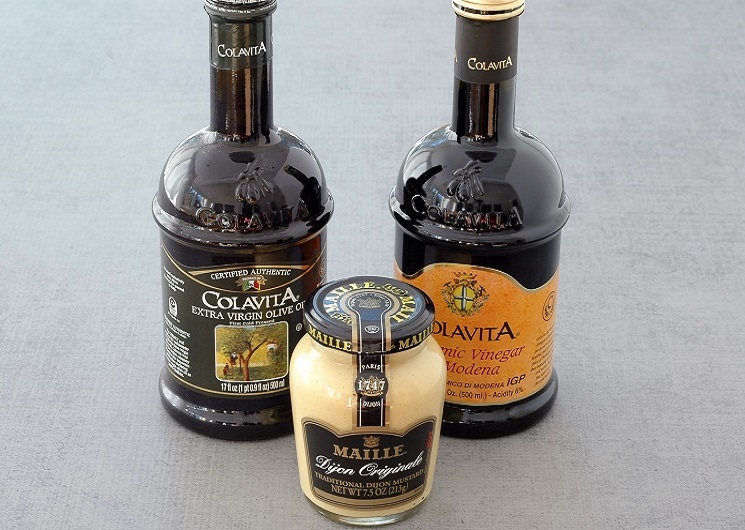One of the most deceptively simple things you can make at home is a vinaigrette salad dressing. Not only is it better tasting than what you can find in a store, it’s infinitely healthier and cheaper than its store-bought cousin. The key is understanding how three basic ingredients work together to create the vinaigrette.
In its simplest form, a vinaigrette is a mixture of two substances that under normal circumstances go together like, well, oil and water. The oil is any vegetable (canola), fruit (olive, avocado, or coconut) or nut (walnut, hazelnut, peanut, and sesame) oil. The water is any water-based acidic fluid, such as vinegar (balsamic, red wine, white wine, apple cider) or citrus juice (lemon).
To make the vinaigrette, you must overcome the normal tendency of these two substances to remain separated. You do this by beating or shaking them together so that tiny droplets of the vinegar or lemon juice become evenly dispersed throughout the oil. The result is what food chemists refer to as an emulsion. (Other examples of edible emulsions are mayonnaise and creamy salad dressings such as ranch and blue cheese.)
Unfortunately, since the droplets of vinegar or lemon juice begin to recombine with each other and separate from the oil as soon as the mixing process stops, using these two substances alone creates only a temporary emulsion. To produce an emulsion that is stable enough to stay intact while you dress and eat your salad, you need an emulsifier as your third ingredient. This is a substance that coats the droplets of vinegar or lemon juice and prevents them from joining back together in the oil. The most commonly used emulsifier in vinaigrettes is Dijon mustard, and it is typically blended into the vinegar or lemon juice first, followed by the addition of the oil.
So there you have it. The most basic vinaigrette is made up of just three easy-to-find ingredients: oil, vinegar or lemon juice, and some Dijon mustard. The proportions are up to you. For example, many of the recipes I’ve seen call for 1 teaspoon of Dijon mustard, 1 tablespoon of vinegar or lemon juice, and 3 tablespoons of oil (a ratio of ⅓:1:3). In contrast, I generally prefer to keep the amount of vinegar and oil in my vinaigrettes the same, which means my recipe calls for 1 teaspoon of Dijon mustard and 2 tablespoons each of vinegar and oil (a ratio of ⅓:2:2). However, if I find that I am using a more acidic vinegar (such as the Colavita balsamic vinegar that I used for this post), I’ll add more oil than I usually do in order to temper the stronger taste of the vinegar. Basically, you should let your ingredients and your personal taste be your guides.
Finally, even though the basic recipe for vinaigrette calls for only three ingredients, you’ll probably want to include one or more seasonings. These can be as simple as salt and pepper, dried herbs, minced shallots or garlic, or even a teaspoon or two of fruity jam. (A pinch or two of herb salt would be a perfect, and super easy, addition.) The possibilities are endless.
Everyday Vinaigrette
1 teaspoon Dijon mustard
2 tablespoons balsamic vinegar
4 tablespoons extra virgin olive oil
½ teaspoon herb salt
½ teaspoon black pepper, freshly ground
Instructions
In a small bowl, whisk the Dijon mustard and balsamic vinegar together until the mustard has fully dissolved into the vinegar. Drizzle the olive oil into the mixture, whisking continuously until the oil is fully incorporated and the mixture appears to have thickened slightly. Whisk in the herb salt and pepper.
Tip: This recipe is essentially a template. You can adjust the ingredients and the proportions to suit your tastes. I like the stronger taste of balsamic vinegar, but if you prefer a lighter flavor, then increase the amount of oil relative to the vinegar or use a red wine vinegar. You may also find that certain vinegar/oil combinations go well with certain foods. For example, I like to use rice vinegar and canola oil on cabbage salads and apple cider vinegar and walnut oil to dress a salad with endive, apples, and walnuts.
Tip: You can also adjust the amount. This recipe makes a little more than ¼ cup of vinaigrette, which is enough to dress 10-12 cups of salad greens (about six servings), but you can make a larger amount by multiplying the recipe by whatever factor you prefer. Store any leftover dressing in the refrigerator in a glass jar for 3-5 days. To use, let the cold jar sit at room temperature for 15-20 minutes and then whisk or shake the contents vigorously in order to re-emulsify the ingredients before using them to dress your salad.
Copyright © A Busy Mom’s Kitchen
https://abusymomskitchen.com/2015/01/09/everyday-vinaigrette/







ver y good información, and good recepies